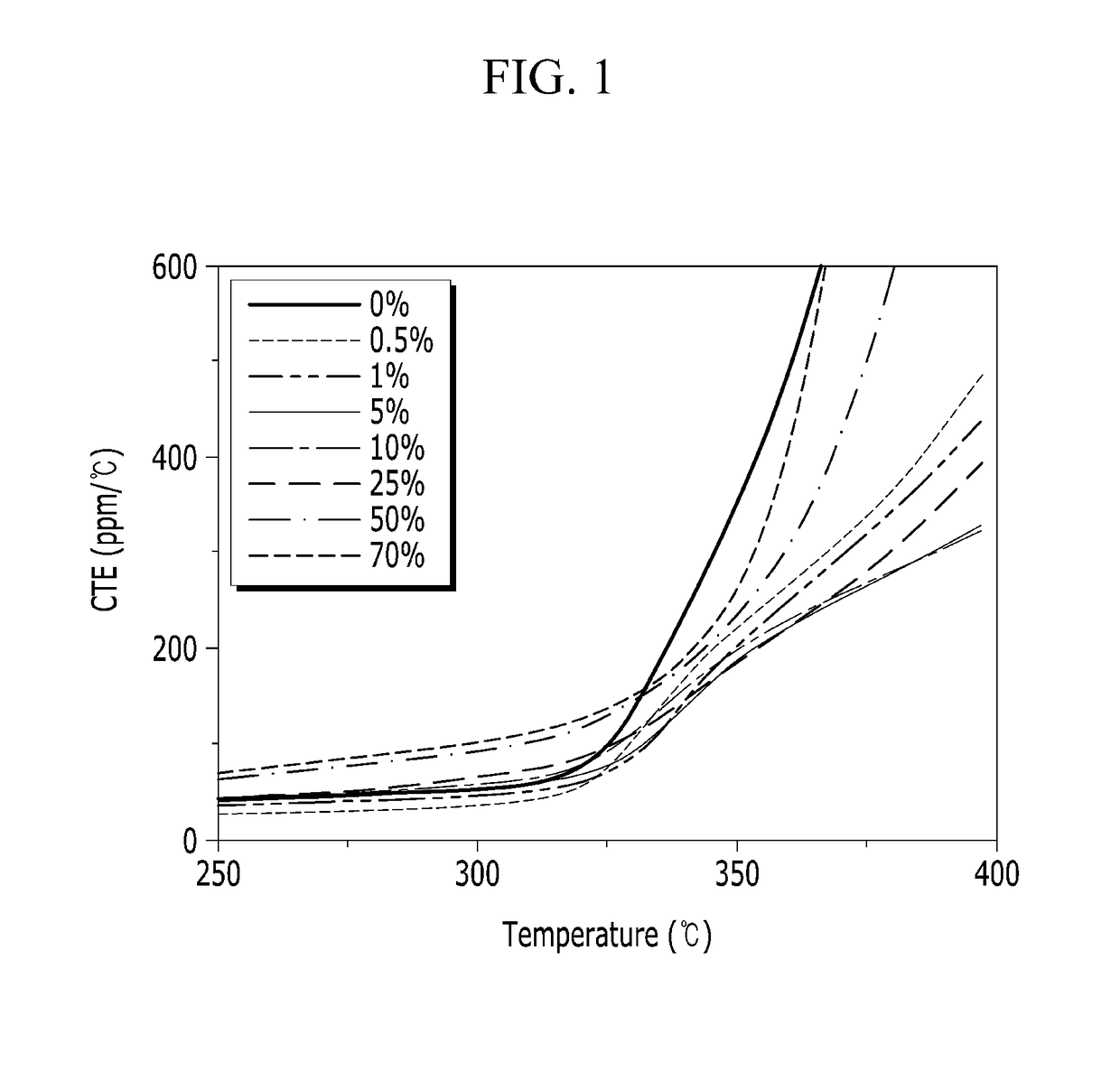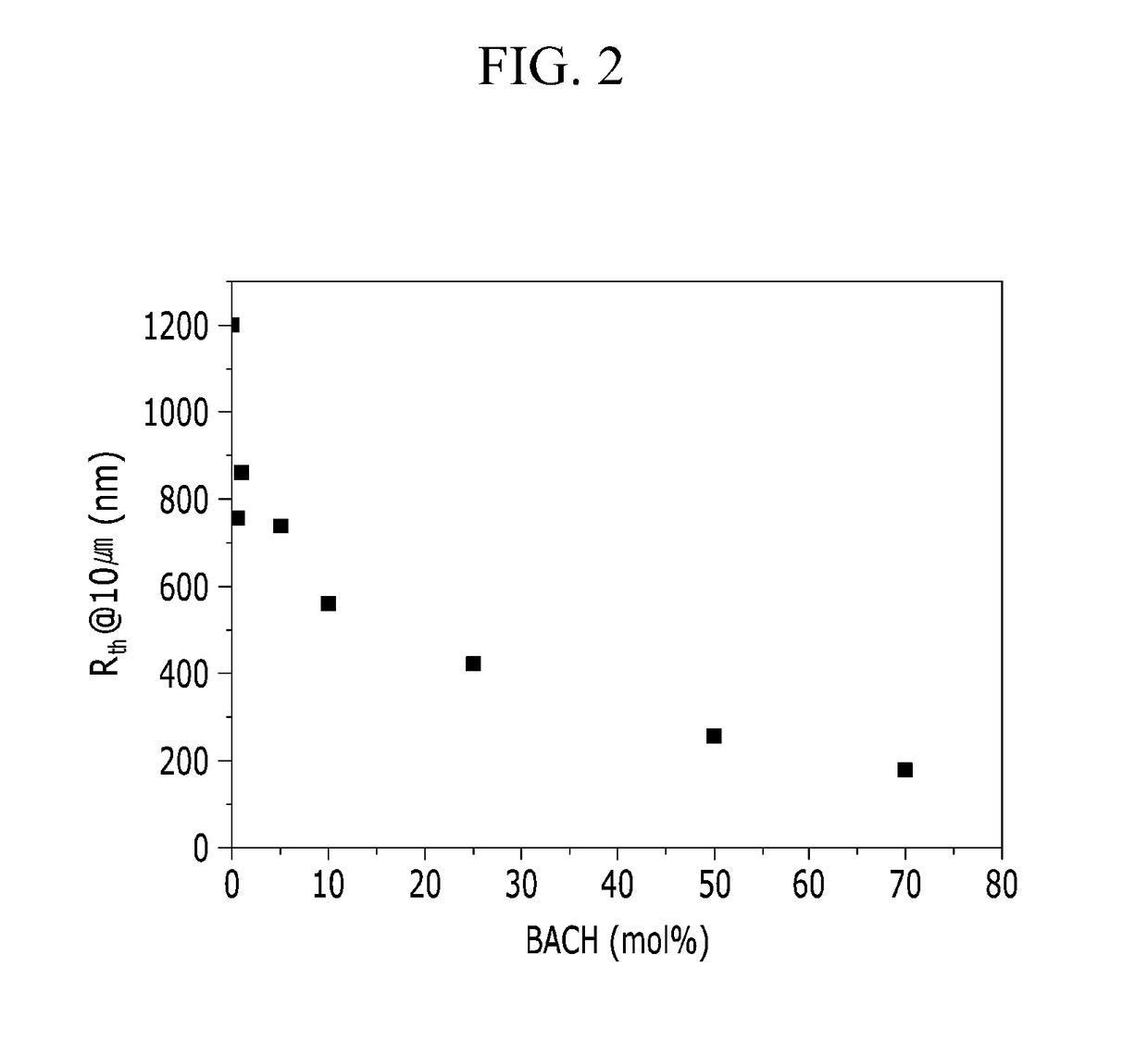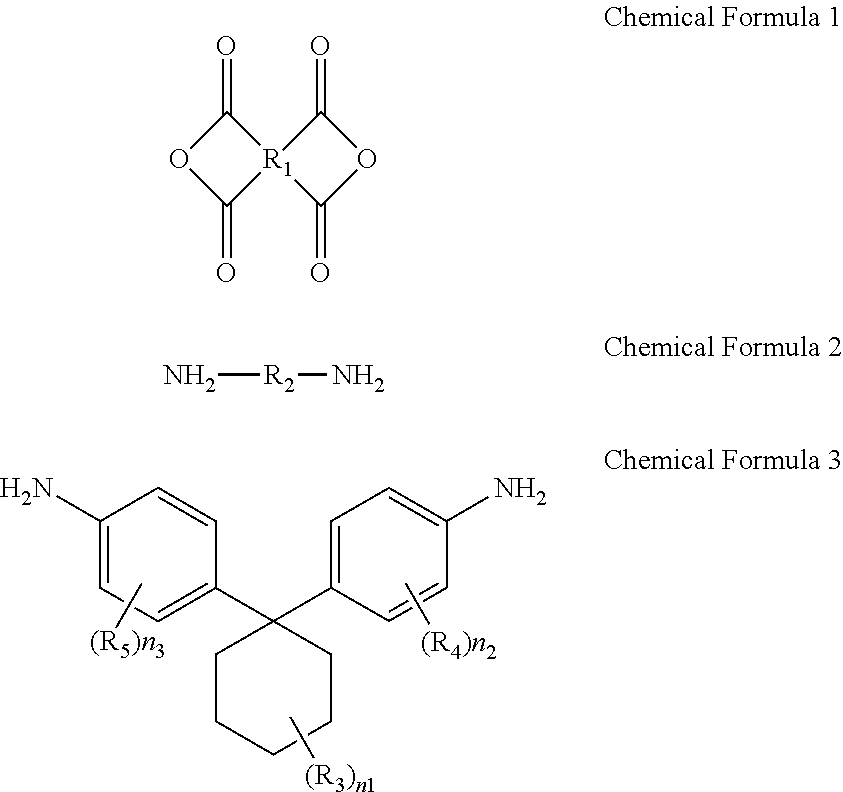Polymer for optical film, and optical film including the same
a technology of optical film and polymer, applied in the direction of optical elements, instruments, coatings, etc., can solve the problems of color shift, thickness retardation, and contrast ratio decreas
- Summary
- Abstract
- Description
- Claims
- Application Information
AI Technical Summary
Benefits of technology
Problems solved by technology
Method used
Image
Examples
examples 1 to 4
Synthesis of Polyamic Acids
[0137]A dianhydride mixture of 80 mol % (3.34 g) of 3, 3′, 4, 4′-biphenyltetracarboxylic dianhydride (“BPDA”) and 20 mol % (0.62 g) of pyromellitic dianhydride (“PMDA”) and a diamine mixture of 2,2′-bis(trifluoromethyl)benzidine (“TFDB”) and 1,1′-bis(4-aminophenyl)cyclohexane (“BACH”) are mixed and polymerized to prepare polyimides. In the diamine mixture, the content of BACH is 0 mol % in Comparative Example 1, 0.5 mol % in Example 1, 1.0 mol % in Example 2, 5.0 mol % in Example 3, 10.0 mol % in Example 4, 25 mol % in Example 5, 50.0 mol % in Comparative Example 2, and 70.0 mol % in Comparative Example 3. 1 mole of the dianhydride mixture and 1 mole of the diamine mixture are reacted to prepare polyamic acid polymers.
[0138]Particularly, 40.4 ml of NMP as a solvent is added to a 250 liter reactor purged with N2 gas, and the diamine mixture of TFDB and BACH is added thereto at room temperature (25° C.). The reaction mixture is agitated at 100 revolutions pe...
synthesis example
Manufacturing Polyimide Films
[0139]The polyamic acids according to Examples 1 to 5 and Comparative Examples 1 to 3 are spin coated on a substrate, and maintained on a hot plate set on 80° C. for 30 minutes for drying. Then the films are put in a furnace, and are heat treated from room temperature to about 300° C. at a heating rate of 10° C. / minute to obtain polyimide films.
[0140]Further, in order to evaluate the films, the films are subject to further heat treatment from room temperature to 300° C. at a heating rate of 10° C. / minute, then maintained at 300° C. for 60 minutes to obtain required films.
experimental example
Evaluation of Properties of the Films
[0141]The film thickness, light transmittance at a specific wavelength, film thickness retardation (Rth), CTE at a specific temperature range, glass transition temperature (“Tg”), and 0.5% weight decrease temperature (“Td0.5”) and 1.0% weight decrease temperature (“Td1.0”) are measured, and the results are summarized in Table 1. The graphs showing changes of CTE and Rth of the films depending on the content of BACH are also shown in FIG. 1 and FIG. 2, respectively.
TABLE 1FilmthicknessTransmittance (%)RthCTE (ppm / ° C.)TgTd0.5Td1.0(μm)380~800 nm400 nm430 nm(nm)50~25050~30050~400(° C.)(° C.)(° C.)Comp.1088508212001113756323485.8524Exam. 1Exam. 188752817581113172331467.2505Exam. 2168861818601215152322468.8501Exam. 3168857797401720113323461.9483Exam. 4108842785602226114320445.6473Exam. 598625684203641148338424.2456Comp.168425542575055336344395.9418Exam. 2Comp.168321471785560664346391.1411Exam. 3
[0142]As shown from Table 1, the polyimide films prepared...
PUM
| Property | Measurement | Unit |
|---|---|---|
| light transmittance | aaaaa | aaaaa |
| temperature | aaaaa | aaaaa |
| mol % | aaaaa | aaaaa |
Abstract
Description
Claims
Application Information
 Login to View More
Login to View More - R&D
- Intellectual Property
- Life Sciences
- Materials
- Tech Scout
- Unparalleled Data Quality
- Higher Quality Content
- 60% Fewer Hallucinations
Browse by: Latest US Patents, China's latest patents, Technical Efficacy Thesaurus, Application Domain, Technology Topic, Popular Technical Reports.
© 2025 PatSnap. All rights reserved.Legal|Privacy policy|Modern Slavery Act Transparency Statement|Sitemap|About US| Contact US: help@patsnap.com



